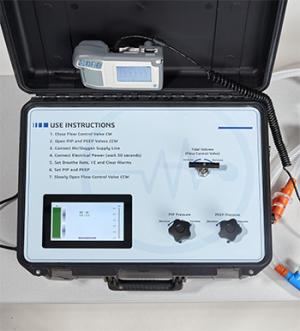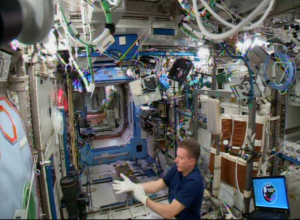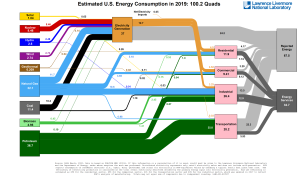LAB REPORT
Science and Technology Making Headlines
May 15, 2020


The Novel Emergency Response Ventilator (NERVe) design incorporates components that are not normally used in ventilator manufacture, to avoid disrupting supply chains for ventilator parts. It is designed to meet the functional requirements of COVID-19 patients requiring mechanical ventilation.
Finding the NERVe
While hospitals across the U.S. faced a possible shortage of mechanical ventilators due to COVID-19, a self-assembled “skunk works” team at Lawrence Livermore National Laboratory (LLNL) worked tirelessly to prototype a simple ventilator design for quick and easy assembly from available parts. But before the prototype can be used with COVID-19 patients, the U.S. FDA must approve it.
Dubbed the “Novel Emergency Response Ventilator” (NERVe), the design is derived from proven concepts and contains parts that are not currently being used by commercial ventilator manufacturers, to avoid disrupting already thin supply chains. It is designed to meet the functional requirements of COVID-19 patients requiring mechanical ventilation, including a simple user interface, air flow circuits for inhalation and exhalation and alarms to notify physicians if air pressures get too low. It can operate in a continuous ventilation mode — common for late-stage COVID-19 patients — but can adapt to patients who spontaneously breathe on their own.
“The LLNL team has rapidly produced and tested prototypes, vetted them with experts and in parallel, is partnering with manufacturing organizations to be able to respond as fast as possible,” says LLNL’s Micro- and Nano Technology Section Leader Jack Kotovsky, who initiated the effort. “The process is similar to a medical device startup compressed from six years to six weeks. The goal is not to make the best machine possible; it’s more important to make the best machine that can be built with available parts, or if we did have to fabricate something, it would have to be very easy to do.”


An astronaut dons gloves before starting to collect samples from an International Space Station environmental surface. Photo courtesy of NASA
Hitchhikers’ guide to the space station
When a new crew member arrives on the International Space Station, the population of humans living in space changes. But so, too, does the population of microbes. Countless types of microorganisms inhabit our bodies, inside and out, and when an astronaut arrives on the station, they bring their specific collection of microbial “hitchhikers” with them.
A new study shows that the microorganisms living on surfaces inside the space station so closely resembled those on an astronaut's skin that scientists could tell when this new crew member arrived and departed, just by looking at the microbes left behind. The findings show how keeping an eye on the tiniest space station residents will be important for protecting the health of astronauts and the spacecraft they occupy. It could even tell us something about relatively closed environments on Earth, like hospitals, where understanding the presence of microbes is key.
Many of the microorganisms living in and around us are harmless or even essential for good health, but some can cause disease or damage structures in built environments. This is why NASA has been following the space station's population of microbes with a series of experiments called Microbial Tracking.
"There's an interplay between the microbial community of the space station and its crew, and understanding the details is important for preventing complications for health or for spacecraft on long-term human space missions," said Crystal Jaing, a biologist at Lawrence Livermore National Laboratory and principal investigator of the Microbial Tracking-2 study.


Clouds can often alter climate models’ results.
Cloudy outlook on climate models
Research teams around the world are working to develop the next generation of climate models. Known as the Coupled Model Intercomparison Project, or CMIP, it's a coordinated, international effort, including Lawrence Livermore scientists, to create suites of ever-more advanced models for use in climate research. There's a new effort every few years or so, typically timed around an upcoming report from the Intergovernmental Panel on Climate Change.
One perplexing trend is emerging. A number of the new models are more sensitive to greenhouse gas emissions than the last generation. In other words, they predict higher warming for a given level of emissions.
Clouds play a major role in the climate’s sensitivity. In fact, they're probably the biggest single uncertainty about future warming, according to Mark Zelinka, an atmospheric scientist at Lawrence Livermore.
That's because clouds can either increase or decrease global warming, depending on their characteristics. And they're notoriously difficult to model. They're probably the "main driver of the differences in climate sensitivity" from one model to the next, Zelinka noted.


The collapse of actuating polymer chains on the contaminated membrane surface prevents nerve agents like sarin from entering the single-walled carbon nanotube pores. In a safe environment, the responsive polymer chains remain extended and allow rapid transport of water vapor, thus conferring high breathability to the membrane material. Image by Ryan Chen/LLNL.
Keeping cool and protected
Soldiers, health care workers and other first responders often face environmental unknowns, such as chemical weapons or COVID-19.
Unfortunately, even state-of-the-art protective clothing does little to prevent contact with harmful chemicals and biological agents. For example, the clothing material must be breathable and let water vapor from the wearer’s body escape to prevent heat stress and exhaustion, but the clothing includes protective adsorbents or barrier layers that prevent it from being breathable.
To provide these workers with better protection, a team of researchers at Lawrence Livermore National Laboratory developed a “smart,” breathable fabric that also fends off biological and chemical warfare agents. Material of this type could be used in clinical and medical settings as well.
“We created a smart material that is both breathable and protective,” says LLNL scientist Francesco Fornasiero. “It combines a membrane layer with trillions of aligned carbon-nanotube pores and a threat-responsive polymer layer grafted onto the membrane surface.”


Energy use in 2019 decreased from the record high use in 2018.
One giant energetic chart
Have you ever wondered where the country’s energy comes from, and how exactly it gets used?
Luckily, Lawrence Livermore National Laboratory (LLNL) crunches the numbers every year, outputting an incredible flow diagram that covers the broad spectrum of U.S. energy use.
The 2019 version of this comprehensive diagram gives an in-depth picture of the U.S. energy ecosystem, showing not only where energy originates by fuel source (i.e. wind, oil, natural gas, etc.), but how it’s ultimately consumed by sector.
Overall energy use in the U.S. actually decreased to 100.2 quads (a quad stands for a quadrillion BTUs) in 2019, similar to a decrease last seen in 2015.
It’s also worth noting that the percentage of fossil fuels used in the 2019 energy mix decreased by 0.2 percent from last year to make up 80 percent of the total. This effectively negates the small rise of fossil fuel usage that occurred in 2018.





